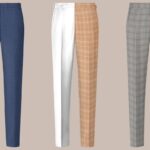Elegance, sophistication, and a timeless personal style are the hallmarks of a discerning gentleman. Central to this sartorial tale are the choices one makes when investing in a suit. For men who value individuality and an impeccable fit, the decision between a bespoke suit and a tailored one is pivotal. Both options promise a custom fit and a refined look, yet they stem from traditions and processes as distinct as they are venerable. In this exhaustive guide, we will unravel the intricacies of Bespoke Suit vs Tailored, catering to fashion enthusiasts, professional men, and anyone seeking to exude a sharp, bespoke style.
Understanding Bespoke Suits
The Artisanal Elegance of Bespoke
The term “bespoke” originates from the once-common practice of customers selecting a cloth from a tailor’s shop and asking for it to be “spoken for.” This process has evolved into a craftsmanship defined by its exclusivity and attention to detail.
The Bespoke Process Unveiled
Creating a bespoke suit is an intimate collaboration between a client and a master tailor. It begins with a detailed set of measurements that map out the contours of an individual’s body. The next step is selecting a fabric that appeals to the client’s aesthetic and complements their lifestyle. This is followed by a series of fittings where the suit is gradually shaped to the client’s form. The end product is a suit that is a second skin — flatteringly cut, perfectly fitted, and unparalleled in personalization.
The Exclusive Benefits
What sets bespoke suits apart is the level of personalization. Every detail manifests the wearer’s personality, from the handpicked fabric to the needlework. This tailoring brand is a statement of luxury and craftsmanship, where the suit is artistry in motion.
Exploring Tailored Suits
The Versatile Charm of Tailored Suits
While not entirely bespoke, a tailored suit offers a high level of customization that distinguishes it from an off-the-rack garment. It combines the efficiency of scale with the adaptability of custom fitting, making it an attractive proposition for many.
Tailoring Process in Detail
Unlike the bespoke experience, tailoring often begins with selecting a suit from a pre-existing template tailored to fit the body. This usually involves a simple set of measurements and a few alterations to ensure a better fit. The client can still select from various fabrics and designs, making it a semi-personalized suit that combines quality with a more efficient production process.
Affordable Elegance
Tailored suits offer a middle ground between bespoke and off-the-rack options. They are more affordable than bespoke suits and have a quicker turnaround while still providing a level of customization that can significantly improve the fit and look of the end product.
Key Differences and Considerations
Fit Like a Glove – Bespoke vs. Tailored
One of the primary differences between bespoke and tailored suits is the fit. With its numerous fittings and precision adjustments, a bespoke suit is closer to a work of art. It mirrors the body’s lines, creating a silhouette unique to the wearer. In contrast, a tailored suit offers a good fit that is refined through alterations but may achieve a different degree of perfection than a bespoke one.
Customization Spectrum
While both bespoke and tailored suits allow customization in fabric, style, and details, bespoke caters to more intricate and personal choices. This ranges from the lapel style to the lining and even monogramming, resulting in a one-of-a-kind garment that tells a story.
Price Point and Personal Context
Bespoke suits are a significant investment, reflecting their labor-intensive and wholly customized nature. They are ideal for special occasions, executives who prize a polished image, and those with hard-to-fit body types. Tailored suits serve as everyday workwear for those looking to elevate their style within a more restrained budget.
Conclusion
The choice between a bespoke and a tailored suit is deeply personal. It hinges on an individual’s priorities, budget, and the role the suit will play in their life. While a bespoke suit is the gold standard in personal tailoring, a well-crafted tailored suit can also deliver a refined look that flatters and endures.
In the noble pursuit of sartorial perfection, may this collection of wisdom guide you. Remember, it’s not just about wearing a suit but about how it makes you feel—confident, poised, and ready to conquer the world, one Bespoke Suit vs Tailored stitch at a time.
Read More: Download
FAQs
What is the difference between a bespoke suit and a tailored suit?
A bespoke suit is a custom-made ensemble designed from scratch to fit the wearer’s unique measurements and style preferences. Every aspect of its creation, from fabric selection to stitching, is tailored to the individual. A tailored suit, on the other hand, begins with a pre-existing design or pattern that is then adjusted to better suit the wearer’s body measurements.
Why should I choose a bespoke suit?
Choosing a bespoke suit means opting for the pinnacle of personalization and fit. It allows for a level of detail in your suit that reflects your style, making it unique. A bespoke suit would be the best choice if you value exclusivity, precision fitting, and artisanal craftsmanship.
Are bespoke suits worth the investment?
Bespoke suits are typically seen as a substantial investment due to their extensive customization and the labor required to create them. This investment is worthwhile for those who prioritize a highly personalized fit, value craftsmanship, and desire a long-lasting wardrobe staple to highlight their style.
How much more expensive are bespoke suits compared to tailored suits?
Bespoke suits can be significantly more expensive than tailored suits as they require more man-hours for measurements, pattern-making, fittings, and hand finishing. The extent of the price difference can vary based on the level of customization, fabric selection, and the tailor’s reputation.
Can I select my fabric for a bespoke suit?
Absolutely! The selection of fabric is a key part of the bespoke process. You can choose from various high-quality materials depending on your style, the occasion, and other preferences.
Is a tailored suit still considered custom-fit?
Yes, a tailored suit is still considered a form of custom-fit clothing. It involves adjusting a predefined suit pattern to fit your measurements better, making it a more personalized fit than off-the-rack options.
How many fittings do I need for a bespoke suit?
The bespoke process typically involves multiple fittings—at least two or three, but sometimes more—to ensure the suit perfectly conforms to your body’s shape and to make any necessary adjustments as the suit is being crafted.
What makes a bespoke suit more comfortable than a tailored suit?
A bespoke suit is constructed specifically for your body shape, which creates an impeccable fit and allows for ease of movement & greater comfort. Tailors consider your posture and body nuances in the bespoke process, which needs to be more finely tuned in a regular tailored suit.
How long does it take to make a bespoke suit?
The time it takes to craft a bespoke suit can range from weeks to months, depending on the tailor’s schedule and the intricacies involved. This process includes consultation, measurements, fittings, and final adjustments.
Is getting a tailored suit worth it if I’m on a limited budget?
Yes, a tailored suit is a great option for those with a limited budget who still want a customized experience. While it does not offer the same degree of customization as a bespoke suit, it is a significant step up from off-the-rack in terms of fit and personal style.



No Comment! Be the first one.